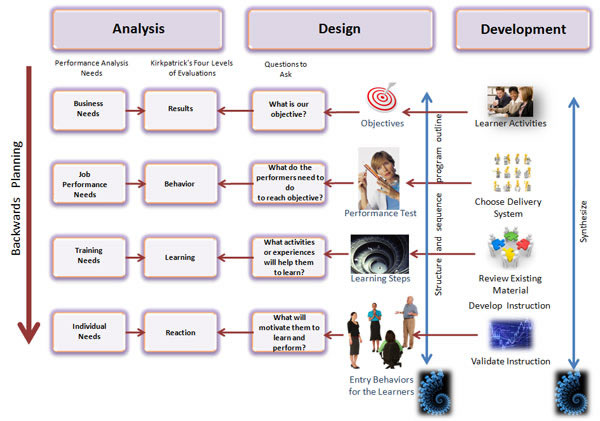Development Phase
This phase elaborates and builds on the Learning Objectives and Performance Steps that were produced in the design phase by fleshing out all the previous content that was created in the prior two phases, Analysis and Design, into a complete learning environment. The end result is the learning platform — the content, such as software, lesson outlines, performance aids, and media, that contains the instructional content and activities that will aid the learners in their quest for better performance.

Design verses Development

Note that in some Instructional Design circles, development is lumped together with the design phase. This is normally truer in smaller organizations where one or two instructional designers are responsible for creating the entire learning platform. In larger organizations, instructional designers normally create the learning blueprint (Design); while other personnel, such as artists, technical writers, programmers, etc. assist them in creating the various activities as dictated by the blueprint.
Backwards Planning in the Development Phase
The backwards planning model has six activities in the Development Phase that directly support the Performance Needs. The chart below shows the six activities, while below it are the six activities listed in more detail.

The Six Major Developmental Activities
List Learner Activities (Practice)
Activities are designed to assist the learners to master the learning objectives. The activities are chosen on the basis that they will help the learners gain the needed skills and knowledge to support the Business Needs.
In addition, create performance aids that the learners can use on the job. Performance aids are a great way to assist the learners perform their tasks in that they reduce cognitive load and the learning time, and provide information that is not used on a daily basis, thus easily forgotten.
For more information, see List Learner Activities.
Choose Delivery System
The medium is selected that will not only best deliver the learning platform to the learners, but also has the least interruption on their jobs. This means it should stream into their workflow as much as possible, rather than cause a cessation of their workflow. This can be often done by using performance aids, social media, informal learning techniques, etc.
For more information, see Choose Delivery System
Review Existing Material
A search should be performed to see if any preexisting content can be recycled to meet the performance needs. This helps to prevent “reinventing the wheel.”
For more information, see Review Existing Material
Develop Instruction
The courseware (instructional material), such as the activities, performance aids, content, context, etc. are created so that the best learning environment is provided.
One of the more important concepts are the activities that take place in the learning environment. Activities are participative learning experiences, such as exercises, role plays, games, and surveys that allow the learners to practice and reflect in order to master a skill.
See learning activities for a description of various activities.
For some learning activity examples, see Leadership Learning Activities.
For more information, see Develop Instruction.
Synthesize
The parts of the courseware are combined into a coherent whole so that it best integrates the information and activities into a learning platform that fosters performance. When synthesizing the learning activities and processes you often have to use an iterative or prototype to achieve the best learning environment. This is because ADDIE or ISD is dynamic, not linear.
For more information, see Synthesize
Validate Instruction
Ensure the learning platform helps the learners to reach the business objective and informs them of the need to perform to the required standards. Validation may best be achieved through the use of small group trials, iterations, and evaluations.
The map below shows how the development phase fits in with the first two phases (analysis and design):

Click for larger image
For more information, see Validate Instruction
Next Steps
Go to the next section: List Learner Activities
Return to the Table of Contents
References
Watson, R. (1981). Instructional System Development. Paper presented to the International Congress for Individualized Instruction. EDRS publication ED 209 239.
Branson, R.K. (1975). Interservice procedures for instructional systems development: Executive summary and model. Tallahassee, FL: Center for Educational Technology, Florida State University. (National Technical Information Service. (Document Nos. AD-A019 486 to AD-A019490).
Branson, R.K., Rayner, G.T., Cox, J.L., Furman, J.P., King, F.J., Hannum, W.H. (1975). Interservice procedures for instructional systems development. (5 vols.) (TRADOC Pam 350-30 NAVEDTRA 106A.) Ft. Monroe, VA: U.S. Army Training and Doctrine Command, August 1975. (NTIS No. ADA 019 486 through ADA 019 490).
